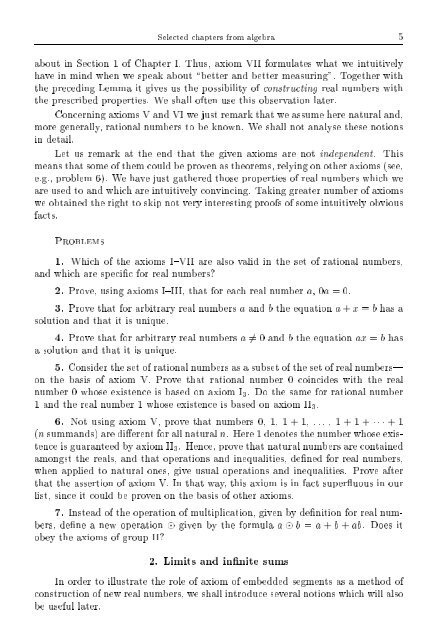SELECTED CHAPTERS FROM ALGEBRA I. R. Shafarevich Preface
SELECTED CHAPTERS FROM ALGEBRA I. R. Shafarevich Preface
SELECTED CHAPTERS FROM ALGEBRA I. R. Shafarevich Preface
Create successful ePaper yourself
Turn your PDF publications into a flip-book with our unique Google optimized e-Paper software.
Selected chapters from algebra 5about in Section 1 of Chapter I. Thus, axiom VII formulates what we intuitivelyhave in mind when we speak about \better and better measuring". Together withthe preceding Lemma it gives us the possibility ofconstructing real numbers withthe prescribed properties. We shall often use this observation later.Concerning axioms V and VI we just remark that we assume here natural and,more generally, rational numbers to be known. We shall not analyse these notionsin detail.Let us remark at the end that the given axioms are not independent. Thismeans that some of them could be proven as theorems, relying on other axioms (see,e.g., problem 6). We have just gathered those properties of real numbers which weare used to and which are intuitively convincing. Taking greater numberofaxiomswe obtained the right to skip not very interesting proofs of some intuitively obviousfacts.Problems1. Which of the axioms I{VII are also valid in the set of rational numbers,and which are specic for real numbers?2. Prove, using axioms I{III, that for each realnumber a, 0a =0.3. Prove that for arbitrary real numbers a and b the equation a + x = b has asolution and that it is unique.4. Prove that for arbitrary real numbers a 6= 0 and b the equation ax = b hasa solution and that it is unique.5. Consider the set of rational numbers as a subset of the set of real numbers|on the basis of axiom V. Prove that rational number 0 coincides with the realnumber 0 whose existence is based on axiom I 3 . Do the same for rational number1 and the real number 1 whose existence is based on axiom II 3 .6. Not using axiom V, prove thatnumbers 0, 1, 1+1, ... , 1+1++1(n summands) are dierent for all natural n. Here 1 denotes the number whose existenceis guaranteed by axiom II 3 . Hence, prove that natural numbers are containedamongst the reals, and that operations and inequalities, dened for real numbers,when applied to natural ones, give usual operations and inequalities. Prove afterthat the assertion of axiom V. In that way, this axiom is in fact superuous in ourlist, since it could be proven on the basis of other axioms.7. Instead of the operation of multiplication, given by denition for real numbers,dene a new operation given by the formula a b = a + b + ab. Does itobey the axioms of group II?2. Limits and innite sumsIn order to illustrate the role of axiom of embedded segments as a method ofconstruction of new real numbers, we shall introduce several notions which will alsobe useful later.
















